|
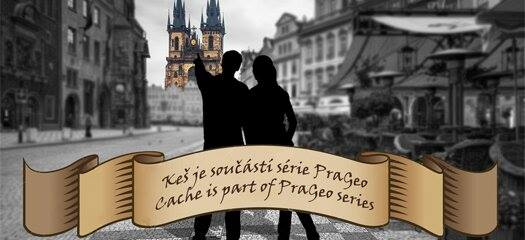
 Vítejte u multi-kešky, která má za cíl vám poodhalit zajímavá místa staré Prahy, která běžně nenajdete v průvodcích. Dost možná je neznají ani místní a přitom je škoda na ně neupozornit. Pokud vás zaujmou natolik, že si další zajímavosti začnete vyhledávat sami, tím lépe. O vaše zkoumání se prosím podělte do logu. Na úvodních souřadnicích keš nehledejte. Procházka je dlouhá asi 4 km. Procházku můžete spojit s odlovem pěkné multi Domovní znamení nebo The Royal Road, které vedou stejným směrem. Děkuji kačerovi Altaria a ufemezumik za pomoc s anglickým překladem! Vítejte u multi-kešky, která má za cíl vám poodhalit zajímavá místa staré Prahy, která běžně nenajdete v průvodcích. Dost možná je neznají ani místní a přitom je škoda na ně neupozornit. Pokud vás zaujmou natolik, že si další zajímavosti začnete vyhledávat sami, tím lépe. O vaše zkoumání se prosím podělte do logu. Na úvodních souřadnicích keš nehledejte. Procházka je dlouhá asi 4 km. Procházku můžete spojit s odlovem pěkné multi Domovní znamení nebo The Royal Road, které vedou stejným směrem. Děkuji kačerovi Altaria a ufemezumik za pomoc s anglickým překladem!
Nezapomeňte si během cesty prohlédnout i reference waypointy!
Zajímavosti v logách od dalších kačerů, děkuji!
Viburnus
plysa - jesličková procházka
Zagloba - perlička k 8 štaci
Doplňující atributy :)
    
 Welcome to a multi-cache which aims to show you some Prague interesting places which can’t be found in traditional tourist guides – maybe even the local people might not know about them, but it would be a shame to miss them! And if this motivate you for a further search for such minutiae, even better. During this walk, you can also look for a nice multi-cache „House signs“ or „The Royal Road“, which lead in the same direction. Cache is not on the given coordinates. Walk in one direction is about 4 km long. Have a fun! Welcome to a multi-cache which aims to show you some Prague interesting places which can’t be found in traditional tourist guides – maybe even the local people might not know about them, but it would be a shame to miss them! And if this motivate you for a further search for such minutiae, even better. During this walk, you can also look for a nice multi-cache „House signs“ or „The Royal Road“, which lead in the same direction. Cache is not on the given coordinates. Walk in one direction is about 4 km long. Have a fun!
Dont forget to look at the reference waypoints during the walk!
1. STAGE
Uťatá ruka (The severed arm)
N 50°05.298 E 014°25.472
  Ke kostelu před kterým se nacházíte, se váže zajímavá pověst. Dřevěná soška Panny Marie na oltáři byla považována za zázračnou a byla vždy ověšena drahocennostmi. Jednou po bohoslužbě se v kostele nechal přes noc zavřít zloděj. Když se chtěl zmocnit těchto pokladů, socha jej uchopila za paži, z tohoto sevření se již nedostal a až ráno jej našel kostelník. Zloděje se nepodařilo dostat ze sevření a tak mu musela být ruka uťata. Useknutá ruka byla pak pro výstrahu pověšena na zeď kostela a visí zde dodnes. Ruka visí na zdi uvnitř vpravo od vchodu do kostela ve výšce cca 4metrů. Více o tomto kostelu ZDE Ke kostelu před kterým se nacházíte, se váže zajímavá pověst. Dřevěná soška Panny Marie na oltáři byla považována za zázračnou a byla vždy ověšena drahocennostmi. Jednou po bohoslužbě se v kostele nechal přes noc zavřít zloděj. Když se chtěl zmocnit těchto pokladů, socha jej uchopila za paži, z tohoto sevření se již nedostal a až ráno jej našel kostelník. Zloděje se nepodařilo dostat ze sevření a tak mu musela být ruka uťata. Useknutá ruka byla pak pro výstrahu pověšena na zeď kostela a visí zde dodnes. Ruka visí na zdi uvnitř vpravo od vchodu do kostela ve výšce cca 4metrů. Více o tomto kostelu ZDE
Otázka1: Přímo nad vchodem do kostela drží několik soch zlaté věci. Kolik těch věcí je? (A=2), (A=4), (A=6).
 There is a very interesting legend concerning the church you’re standing in front of. The wooden statue of Our Lady was considered miraculous, with lots of jewelery hanging from it all the time. Once, after the church service, a thief let himself be locked up in the church. When he was about to steal the jewelery, the statue grabbed him be the arm. He was not able to get away from the clasp and was found in the morning by the verger. No amount of effort would set the thief free from the statue’s grip and so his arm had to be cut off. The severed arm was then hung on the church’s wall as a warning and hangs there even today. You can see the arm inside on a wall just right from the cathedral’s entrance, about 4 meters above ground. You can find out more about this church HERE. There is a very interesting legend concerning the church you’re standing in front of. The wooden statue of Our Lady was considered miraculous, with lots of jewelery hanging from it all the time. Once, after the church service, a thief let himself be locked up in the church. When he was about to steal the jewelery, the statue grabbed him be the arm. He was not able to get away from the clasp and was found in the morning by the verger. No amount of effort would set the thief free from the statue’s grip and so his arm had to be cut off. The severed arm was then hung on the church’s wall as a warning and hangs there even today. You can see the arm inside on a wall just right from the cathedral’s entrance, about 4 meters above ground. You can find out more about this church HERE.
Question1: Right above the church entrance, several statues are holding some golden objects. How many such objects are there? (A=2), (A=4), (A=6).
2. STAGE
Portál chrámu Panny Marie před Týnem (Portal of the church of Our Lady Before Týn)
N 50°05.275 E 014°25.367
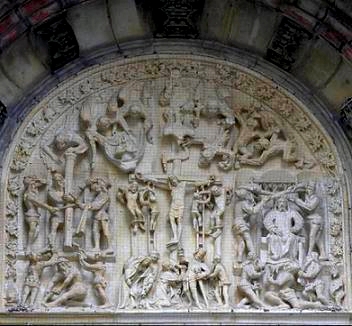  Právě se nacházite před severním portálem chrámu Panny Marie před Týnem, který patří k nejcennějším památkám vrcholné gotiky. Reliéf znázorňuje Kristovo "velké" ukřižování, po jeho boku jsou ukřižování i dva lotři, které opouštějí jejich duše. Po levici se o duši rvou ďáblové, o duši po pravici, jenž na kříži uvěřil v Krista, odnášejí andělé do nebes. Mistrovské dílo vytvořila slavná huť Petra Parléře, která se podílela např. na stavbě Karlova mostu, Staroměstské mostecké věže, dostavby hradu Karlštejn, Staroměstské radnice, výzdoby orloje a mnoho dalšího. Právě se nacházite před severním portálem chrámu Panny Marie před Týnem, který patří k nejcennějším památkám vrcholné gotiky. Reliéf znázorňuje Kristovo "velké" ukřižování, po jeho boku jsou ukřižování i dva lotři, které opouštějí jejich duše. Po levici se o duši rvou ďáblové, o duši po pravici, jenž na kříži uvěřil v Krista, odnášejí andělé do nebes. Mistrovské dílo vytvořila slavná huť Petra Parléře, která se podílela např. na stavbě Karlova mostu, Staroměstské mostecké věže, dostavby hradu Karlštejn, Staroměstské radnice, výzdoby orloje a mnoho dalšího.
Otázka2: Přímo pod portálem jsou krásné dveře, co je vyobrazeno na madle napravo od zámku? Růže(B=1), Žena(B=2), Kost(B=3)
 You are now standing in front of the north portal of the church of Our Lady Before Týn, one of the most valued monuments of the decorated Gothic style. The relief pictures the „great“ crucifixion of Christ, with two villains also crucified by his side, their souls leaving their bodies. On the left, two devils fight over one soul, on the right, the soul of him who found belief in Christ on his cross is carried to heaven by angels. This masterpiece was created by the famous smelt house of Peter Parléř, which also took part in the construction of the Charles Bridge, the Old Town Bridge Tower, completion of the Karlštejn castle, Old Town City Hall, the Astronomical Clock and many others. You are now standing in front of the north portal of the church of Our Lady Before Týn, one of the most valued monuments of the decorated Gothic style. The relief pictures the „great“ crucifixion of Christ, with two villains also crucified by his side, their souls leaving their bodies. On the left, two devils fight over one soul, on the right, the soul of him who found belief in Christ on his cross is carried to heaven by angels. This masterpiece was created by the famous smelt house of Peter Parléř, which also took part in the construction of the Charles Bridge, the Old Town Bridge Tower, completion of the Karlštejn castle, Old Town City Hall, the Astronomical Clock and many others.
Question2: Now look at the beautiful door right under the portal, what can you see on the handle that is placed on the right side of the lock? Rose(B=1), woman(B=2), bone(B=3).
3. STAGE
Vyvýšená Praha (The raised Prague)
N 50°05.258 E 014°25.316
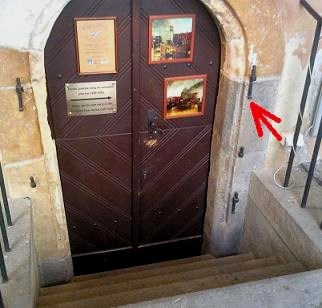
 Zde se nacházíte u zajímavosti, kterou si mnohdy nevšimne ani místní. Ve 13. století byla ve městě postavena řada mlýnů, k nim se postavily jezy, jenže se tím zvedla hladina Vltavy, Praha trpěla velmi častými a dlouhými povodněmi. Začala se tedy ve velkém zavážet hlínou a co bylo dřív přízemím, se změnilo na sklepení. Praha má díky tomu do dnešních dob uchovánu řadu původních románských interiérů. Mohutná přestavba trvala přes 50 let a nedochovaly se o ní žádné písemné doklady. Přímo v ulicích je ale několik míst, kde si tohoto jevu všimneme. Když se v podloubí podíváte na dveře, které jsou pod úrovní země, okolo nich uvidíte panty, které směřují ven. Byly zde dveře, které se otevíraly ven, dnes už by se díky schodům neotevřely. Panty jsou zde z doby, kdy tento vstup byl v úrovni země. Nyní zvedněte hlavu a obdivujte ozdoby uprostřed gotických stropů. Na jednom je i tzv. Zelený muž, více o něm ZDE. Zde se nacházíte u zajímavosti, kterou si mnohdy nevšimne ani místní. Ve 13. století byla ve městě postavena řada mlýnů, k nim se postavily jezy, jenže se tím zvedla hladina Vltavy, Praha trpěla velmi častými a dlouhými povodněmi. Začala se tedy ve velkém zavážet hlínou a co bylo dřív přízemím, se změnilo na sklepení. Praha má díky tomu do dnešních dob uchovánu řadu původních románských interiérů. Mohutná přestavba trvala přes 50 let a nedochovaly se o ní žádné písemné doklady. Přímo v ulicích je ale několik míst, kde si tohoto jevu všimneme. Když se v podloubí podíváte na dveře, které jsou pod úrovní země, okolo nich uvidíte panty, které směřují ven. Byly zde dveře, které se otevíraly ven, dnes už by se díky schodům neotevřely. Panty jsou zde z doby, kdy tento vstup byl v úrovni země. Nyní zvedněte hlavu a obdivujte ozdoby uprostřed gotických stropů. Na jednom je i tzv. Zelený muž, více o něm ZDE.
Otázka3: U dveří zvedněte hlavu, uprostřed stropu je první ozdoba v podobě? květu(C=1), měsíce(C=2), orlice(C=3).
 This very interesting place often goes unnoticed even by the locals. In the 13th century, many mills were built in the city, accompanied by weirs. Unfortunatelly, this caused Vltava’s water level to raise and Prague suffered very frequent and long floods. Large amount of clay was therefore carried to the banks, turning ground levels to cellars. As an effect, many of the original Prague Romanesque interiors were preserved to date. The enormous reconstruction lasted for more than 50 years, with no written evidence documenting it. You can nevertheless find some evidence of this phenomenon right in the streets. In the arcade, when you take a look at the door below the ground level, you will see hinges directed outwards. In the past, there was a door opening outwards which could not be opened today due to the stairs. The hinges remained here from the time when this entrance was still at ground level. This very interesting place often goes unnoticed even by the locals. In the 13th century, many mills were built in the city, accompanied by weirs. Unfortunatelly, this caused Vltava’s water level to raise and Prague suffered very frequent and long floods. Large amount of clay was therefore carried to the banks, turning ground levels to cellars. As an effect, many of the original Prague Romanesque interiors were preserved to date. The enormous reconstruction lasted for more than 50 years, with no written evidence documenting it. You can nevertheless find some evidence of this phenomenon right in the streets. In the arcade, when you take a look at the door below the ground level, you will see hinges directed outwards. In the past, there was a door opening outwards which could not be opened today due to the stairs. The hinges remained here from the time when this entrance was still at ground level.
Question3: At the door, rise your head. In the middle of the ceiling, there’s a first decoration depicting: Flower(C=1), Moon(C=2), Eagle(C=3).
4. STAGE
Myší díra (The Mouse hole)
N 50°05.203 E 014°25.298
  Myší dírou jsem nazval opomíjený vstup do malé uličky, vyhnete se zde davům turistů, což je jeden z cílů této multiny. Přivést vás do míst, okolo kterých většina jen proběhne a přitom právě v nich se skrývá genius loci tohoto města. Nebojte se vstoupit a nasát atmosféru. Myší dírou jsem nazval opomíjený vstup do malé uličky, vyhnete se zde davům turistů, což je jeden z cílů této multiny. Přivést vás do míst, okolo kterých většina jen proběhne a přitom právě v nich se skrývá genius loci tohoto města. Nebojte se vstoupit a nasát atmosféru.
Otázka4: Myší díra začíná průchodem, na jehož stropě nalezneme? Zavěšeného draka(D=2), světla(D=3), malbu myši(D=4).
 “The Mouse hole“ is a name given by me to an entrance of a small alley. By going through there, you can avoid large crowds of turists, which is one of the aims of this multicache – to take you to places through which people usually pass without notice, although this is exactly where the true „genius loci“ of this city can be found. Don’t be afraid to enter and feel the atmosphere. “The Mouse hole“ is a name given by me to an entrance of a small alley. By going through there, you can avoid large crowds of turists, which is one of the aims of this multicache – to take you to places through which people usually pass without notice, although this is exactly where the true „genius loci“ of this city can be found. Don’t be afraid to enter and feel the atmosphere.
Question4: The Mouse hole starts with a passage, in the ceiling of which we can find: Hanging dragon(D=2), lights(D=3), painting of a mouse(D=4).
5. STAGE
Temný průchod (The Dark passage)
N 50°05.156 E 014°25.281
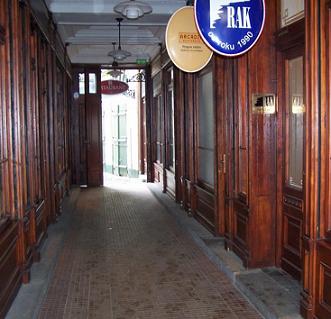  Nacházíte se v křivolaké uličce, jejíž název pochází od domu čp. 499/8, kde byl v 19. století sklad a obchod s kůžemi. Kousek od vás se nachází obchodní pasáž spojující tuto uličku s ulicí Havelskou. Jde o celkem slavnou pasáž, ve které se natáčela jedna ze scén filmu Záhada hlavolamu. V čase filmu 14:42 chlapce v tmavém průchodu vyděsí hrůzný výkřik. Můžete porovnat, jak se místo změnilo, už nevypadá tak ponuře, takže se nebojte vstoupit. Záběr z filmu ZDE. Nacházíte se v křivolaké uličce, jejíž název pochází od domu čp. 499/8, kde byl v 19. století sklad a obchod s kůžemi. Kousek od vás se nachází obchodní pasáž spojující tuto uličku s ulicí Havelskou. Jde o celkem slavnou pasáž, ve které se natáčela jedna ze scén filmu Záhada hlavolamu. V čase filmu 14:42 chlapce v tmavém průchodu vyděsí hrůzný výkřik. Můžete porovnat, jak se místo změnilo, už nevypadá tak ponuře, takže se nebojte vstoupit. Záběr z filmu ZDE.
Otázka5: Po levé straně domu, kde je tento průchod, vidíte lampu. Co je na ní zvláštního? Přimontované halogen světlo(E=4), Je světle modrá(E=5), Je porostlá břečťanem(E=6).
 You find yourself in a crooked alley whose name comes from the house No. 499/8, where a leather warehouse and store were placed in the 19th century. Few steps from you, there is a passage with shops connecting this alley with the Havelská street. This passage is rather famous, one of the scenes from the „Záhada hlavolamu“ movie was shot on this location. You can see for yourself how the place has changed over time – it no longer looks that grim, so don’t be afraid to enter. The movie scene can be found HERE. You find yourself in a crooked alley whose name comes from the house No. 499/8, where a leather warehouse and store were placed in the 19th century. Few steps from you, there is a passage with shops connecting this alley with the Havelská street. This passage is rather famous, one of the scenes from the „Záhada hlavolamu“ movie was shot on this location. You can see for yourself how the place has changed over time – it no longer looks that grim, so don’t be afraid to enter. The movie scene can be found HERE.
Question5: On the left side of the house where the passage is placed you can see a lamp. There is something special about this lamp. Another light(E=4), blue color(E=5), it is overgrown with plants(E=6).
6. STAGE
Zrušený kostel (The Deconsecrated church)
N 50°05.164 E 014°25.218
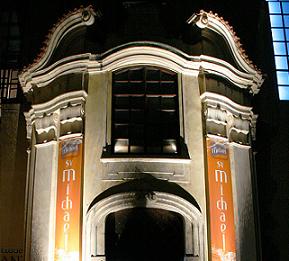  K další zastávce rychle proběhneme proudícím davem turistů a dalším průchodem se dostaneme k jednomu z nejstarších kostelů v Praze. Kostel vznikl už kolem roku 1150. V roce 1786 byl ale zrušen, později sloužil jako skladiště a po roce 1990 v něm byla instalována podle mnohých zvláště nevkusná kýčovitá show, představující české dějiny, která byla později ukončena. Dnes je v kostele hudební klub. Bývalý kostel se tak stal jakousi nepěknou ukázkou přístupu k památkovému dědictví v naší moderní historii, skrytou před davem turistů, který proudí ve vedlejší ulici. K další zastávce rychle proběhneme proudícím davem turistů a dalším průchodem se dostaneme k jednomu z nejstarších kostelů v Praze. Kostel vznikl už kolem roku 1150. V roce 1786 byl ale zrušen, později sloužil jako skladiště a po roce 1990 v něm byla instalována podle mnohých zvláště nevkusná kýčovitá show, představující české dějiny, která byla později ukončena. Dnes je v kostele hudební klub. Bývalý kostel se tak stal jakousi nepěknou ukázkou přístupu k památkovému dědictví v naší moderní historii, skrytou před davem turistů, který proudí ve vedlejší ulici.
Otázka6: Po pravé straně od kostela, je u zdi domu v podlaze výtah, jakou má nosnost? 250kg(F=4), 300(F=5), 400(F=6).
 We run through the streaming crowd of turists and through another passage which will take us to our next stage, one of the oldest churches in Prague. It dates back as far as to 1150. In 1786, though, it was deconsecrated and served as a warehouse in the following years. In 1990, a special show, considered by many to be extremely trashy – depicting the history of the Czech nation was installed in the church, only to be cancelled later. Nowadays, the church serves as a music club. The former church thus became an unfortunate illustration of our modern approach towards some of our historical inheritance, hidden from the tourists streaming down the adjacent street. We run through the streaming crowd of turists and through another passage which will take us to our next stage, one of the oldest churches in Prague. It dates back as far as to 1150. In 1786, though, it was deconsecrated and served as a warehouse in the following years. In 1990, a special show, considered by many to be extremely trashy – depicting the history of the Czech nation was installed in the church, only to be cancelled later. Nowadays, the church serves as a music club. The former church thus became an unfortunate illustration of our modern approach towards some of our historical inheritance, hidden from the tourists streaming down the adjacent street.
Question6: On the right side of the church, on the small square next to the wall you can see a small elevator heading underground. What is its lifting capacity? 250kg(F=4), 300(F=5), 400(F=6).
7. STAGE
Květinový oltář (The Flower altar)
N 50°05.134 E 014°25.094
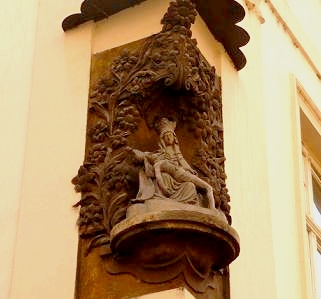
 Pokud je otevřena, tak Hlavsovou ulicí, se dostaneme k domu čp. 243 s hezkou pietou v netradičním krásném květinovém oltáři. K domu se váže zajímavá historka. Ve čtyřicátých letech 19. století se zde na popud Karla Šimanovského (člen Stavovského a Národního divadla) hrála divadelní představení jím založeného ochotnického spolku. Jenže divadlo nebylo oficiálně povoleno ani nahlášeno, takže se před domem objevila policie. Šimanovský vyskočil přízemním oknem a v kostýmu loupežníka, kterého zrovna hrál, utekl pryč. Jeho další herecká kariéra byla už šťastnější. Pokud je otevřena, tak Hlavsovou ulicí, se dostaneme k domu čp. 243 s hezkou pietou v netradičním krásném květinovém oltáři. K domu se váže zajímavá historka. Ve čtyřicátých letech 19. století se zde na popud Karla Šimanovského (člen Stavovského a Národního divadla) hrála divadelní představení jím založeného ochotnického spolku. Jenže divadlo nebylo oficiálně povoleno ani nahlášeno, takže se před domem objevila policie. Šimanovský vyskočil přízemním oknem a v kostýmu loupežníka, kterého zrovna hrál, utekl pryč. Jeho další herecká kariéra byla už šťastnější.
Otázka7: Po levé straně je hlavní vchod do domu, na jeho dveřích je velká tlama svírající v ústech? Rostlinu(G=7), kost(G=8), roubík(G=9).
 If the Hlavsova street is open for public, we walk towards the house No. 243 with a nice piety statue in an unusual beautiful flower altar. An interesting story is told about this house. In the 40‘s of the 19th century, this place hosted theatrical pieces on behalf of Karel Šimanovský (a member of the Estate and National theater), played by an amateur actors group which he had founded. However, this theater was neither officially authorised nor reported, which made the police appear in front of the house. Šimanovský jumped through a ground-level window and run away in his highwayman costume. His further actor’s career is said to be rather more fortunate. If the Hlavsova street is open for public, we walk towards the house No. 243 with a nice piety statue in an unusual beautiful flower altar. An interesting story is told about this house. In the 40‘s of the 19th century, this place hosted theatrical pieces on behalf of Karel Šimanovský (a member of the Estate and National theater), played by an amateur actors group which he had founded. However, this theater was neither officially authorised nor reported, which made the police appear in front of the house. Šimanovský jumped through a ground-level window and run away in his highwayman costume. His further actor’s career is said to be rather more fortunate.
Question7: To the left, you see a house entrance, upon which rests a maw holding: a plant(G=7), a bone(G=8), a gag(G=9).
8. STAGE
Záhadný patník (A Mysterious Bollard)
N 50°05.105 E 014°25.098
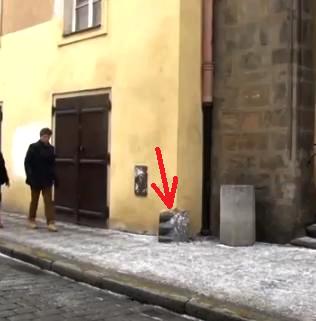  Patníky odjakživa sloužily k ochraně rohu budov, aby se kočáry a další povozy neodíraly o roh domu. Zde ale nalezneme patník, na jehož místě nebyl nikdy potřeba, nevedla tudy žádná cesta. Podle odborníků je patrné, že byl součástí nějaké architektury, kde se tu ale vzal, je záhadou. Kámen pochází z první poloviny 14. století. Hned za rohem jsou v gotickém portálu kamenné podstavce s velmi podobnou strukturou. Patník byl pravděpodobně součástí nějakého již zrušeného portálu a ten kdo ho sem zazdil, jej musel z pro nás dnes již neznámého důvodu považovat za důležitý. Patníky odjakživa sloužily k ochraně rohu budov, aby se kočáry a další povozy neodíraly o roh domu. Zde ale nalezneme patník, na jehož místě nebyl nikdy potřeba, nevedla tudy žádná cesta. Podle odborníků je patrné, že byl součástí nějaké architektury, kde se tu ale vzal, je záhadou. Kámen pochází z první poloviny 14. století. Hned za rohem jsou v gotickém portálu kamenné podstavce s velmi podobnou strukturou. Patník byl pravděpodobně součástí nějakého již zrušeného portálu a ten kdo ho sem zazdil, jej musel z pro nás dnes již neznámého důvodu považovat za důležitý.
Otázka8: Vysoko nad patníkem je erb, co je na něm? Drak(H=7), rostlina(H=8), pták(H=9).
 The bollards were used in the past to protect the corners of buildings from coaches and carriages which might have damaged the masonry. Here, however, we find a bollard in a place where there was never any need for it - no road has ever run through here. According to the experts, it is evident that this bollard was a part of some architecture, but how it found it’s way here remains a mystery. The stone dates back to the first half of the 14th century. Just around the corner, there are stone bases of a very similar structure used in a Gothic portal. The bollard was probably a part of some demolished portal and whoever placed it here must have considered it important, for a reason which we can only guess today. The bollards were used in the past to protect the corners of buildings from coaches and carriages which might have damaged the masonry. Here, however, we find a bollard in a place where there was never any need for it - no road has ever run through here. According to the experts, it is evident that this bollard was a part of some architecture, but how it found it’s way here remains a mystery. The stone dates back to the first half of the 14th century. Just around the corner, there are stone bases of a very similar structure used in a Gothic portal. The bollard was probably a part of some demolished portal and whoever placed it here must have considered it important, for a reason which we can only guess today.
Question8: High above the boundary stone, there’s a coat of arms. What does it show? Dragon(H=7), plant(H=8), bird(H=9).
9. STAGE
Nejstarší patník (The Oldest bollard)
N 50°05.046 E 014°25.097
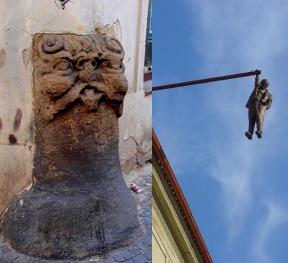
 U patníků ještě zůstaneme. Nyní stojíte u údajně nejstaršího dochovaného pražského patníku. Je to šklebivec s nafouknutými tvářemi, vyplazeným jazykem a zahnutými rohy. Autor neznámý. U patníků ještě zůstaneme. Nyní stojíte u údajně nejstaršího dochovaného pražského patníku. Je to šklebivec s nafouknutými tvářemi, vyplazeným jazykem a zahnutými rohy. Autor neznámý.
O tomto a i jiných patnících se více dočtete v již archivovaném, ale krásném listingu od Mel-mana ZDE. Pokud se tu podíváte nad sebe, uvidíte další zajímavost - Viselce. Je to laminátová plastika od Davida Černého, která byla původně instalovaná na výstavě Respekt 97 v Richterově vile na Malé Straně. Jeho účel je jasný, šokovat kolemjdoucí.
Otázka9: U patníku je značka.: turistické směrovky(I=9), jednosměrka(I=8), zákaz vjezdu(I=7)
 Let’s stay with the bollards for a little longer. You find yourself standing by the oldest bollard of Prague. It’s a grinning face with blown cheeks, twisted horns and tongue sticking out of his mouth. Author is unknown. If you look above your head, you’ll see another interesting piece – the Hanged man. It’s a laminate statue originally installed at the „Respekt 97“ exhibition in Lesser Town’s Richter’s villa. The aim of the statue is evident – to shock the passers-by. Let’s stay with the bollards for a little longer. You find yourself standing by the oldest bollard of Prague. It’s a grinning face with blown cheeks, twisted horns and tongue sticking out of his mouth. Author is unknown. If you look above your head, you’ll see another interesting piece – the Hanged man. It’s a laminate statue originally installed at the „Respekt 97“ exhibition in Lesser Town’s Richter’s villa. The aim of the statue is evident – to shock the passers-by.
Question9: At the boundary stone, there’s a sign: Tourist pointers(I=9), one way(I=8), no entry(I=7).
10. STAGE
Mladá kaple (The Young chapel)
N 50°05.045 E 014°25.030
  Většina Pražanů netuší, že staře se tvářící kaple, o níž mnozí předpokládají, že v ní kázal Mistr Jan Hus, je vlastně jen replikou původní stavby. Od jejího slavnostního otevření uplynulo pouhé půl století. Původní kaple zde vznikla roku 1391. Mistr Jan Hus zde skutečně kázal od roku 1402 do roku 1413. V roce 1786 byla ale pro svůj špatný stav zbořena a prázdná parcela sloužila jako sklad dřeva. V roce 1836 zde byl postaven třípodlažní činžovní dům. Dům byl v roce 1948 vyvlastněn, zbořen a na místě vznikla nová kaple. Na stavbu byl použit i moderní materiál, například železobeton. Většina Pražanů netuší, že staře se tvářící kaple, o níž mnozí předpokládají, že v ní kázal Mistr Jan Hus, je vlastně jen replikou původní stavby. Od jejího slavnostního otevření uplynulo pouhé půl století. Původní kaple zde vznikla roku 1391. Mistr Jan Hus zde skutečně kázal od roku 1402 do roku 1413. V roce 1786 byla ale pro svůj špatný stav zbořena a prázdná parcela sloužila jako sklad dřeva. V roce 1836 zde byl postaven třípodlažní činžovní dům. Dům byl v roce 1948 vyvlastněn, zbořen a na místě vznikla nová kaple. Na stavbu byl použit i moderní materiál, například železobeton.
Otázka10: Podívejte se na krásnou fasádu domu naproti čp. 258/10. Jaké jméno píše dívka uprostřed? Tomek (J=3), Kočí (J=4), Čermák (J=5).
 Most citizens of Prague have no idea that this old-looking chapel in which – as many people suppose – Master Jan Hus was giving his preaches, is really just a replica of the original building. It’s only been fifty years since it’s ceremonial opening. The original chapel was built here in 1391 and Master Jan Hus was in fact preaching here from 1402 to 1413. Nevertheless, in 1786, the chapel was demolished due to it’s very bad state and the empty place served as a wood warehouse. In 1836, a three-storey apartment house was built here. This house got expropriated and was demolished in 1948 and a new chapel was built in it’s place. Modern materials were used in the construction, like ferroconcrete. Most citizens of Prague have no idea that this old-looking chapel in which – as many people suppose – Master Jan Hus was giving his preaches, is really just a replica of the original building. It’s only been fifty years since it’s ceremonial opening. The original chapel was built here in 1391 and Master Jan Hus was in fact preaching here from 1402 to 1413. Nevertheless, in 1786, the chapel was demolished due to it’s very bad state and the empty place served as a wood warehouse. In 1836, a three-storey apartment house was built here. This house got expropriated and was demolished in 1948 and a new chapel was built in it’s place. Modern materials were used in the construction, like ferroconcrete.
Question10: Look at the beautiful facade of the house opposite to number 258/10. What name is the girl in the middle writing? Tomek (J=3), Kočí (J=4), Čermák (J=5).
11. STAGE
Tovární komín (The Factory chimney)
N 50°05.068 E 014°24.894
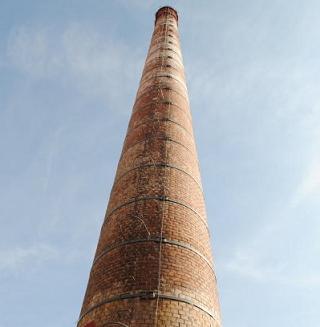
 Že na Starém Městě není tovární komín? Ale je a dokonce jen kousek od rušné Královské cesty. Je ve dvoře bývalého kláštera dominikánek, zrušeného v roce 1782. Patřil k tiskárně, která zde vznikla už v roce 1795. Pěkně starý cvalík, že? Tiskárna vydávala C.K. Poštovské noviny. V roce 1834 byla tiskárna největší v Rakousku. Dnes zde sídlí provozní oddělení Národního divadla a v domečku, stojícím v těsné blízkosti komína, sídlí truhlárna. Že na Starém Městě není tovární komín? Ale je a dokonce jen kousek od rušné Královské cesty. Je ve dvoře bývalého kláštera dominikánek, zrušeného v roce 1782. Patřil k tiskárně, která zde vznikla už v roce 1795. Pěkně starý cvalík, že? Tiskárna vydávala C.K. Poštovské noviny. V roce 1834 byla tiskárna největší v Rakousku. Dnes zde sídlí provozní oddělení Národního divadla a v domečku, stojícím v těsné blízkosti komína, sídlí truhlárna.
Otázka11: Na zdi v uličce Stříbrná sedí dívka a vedle ní je? Malba chlapce(K=6), malba papouška(K=4), nic z toho(K=2).
 You think that there is no factory chimney in the Old Town? Oh, there is one, and what’s more, it’s placed very close to the Royal Road. It stands in the courtyard of the former Dominicans monastery canceled in 1782. The chimney belonged to a printing house established here in 1795. Some really old fat fella, isn’t it? The printing house published the - E.K. Postal newspaper“ and in 1834, this printing house was the largest in Austria. Nowadays, the operating department of the National thater resides here and the small house in the closest vicinity of the chimney serves as a carpenter workshop. You think that there is no factory chimney in the Old Town? Oh, there is one, and what’s more, it’s placed very close to the Royal Road. It stands in the courtyard of the former Dominicans monastery canceled in 1782. The chimney belonged to a printing house established here in 1795. Some really old fat fella, isn’t it? The printing house published the - E.K. Postal newspaper“ and in 1834, this printing house was the largest in Austria. Nowadays, the operating department of the National thater resides here and the small house in the closest vicinity of the chimney serves as a carpenter workshop.
Question11: There’s a girl sitting on the wall in the small street Sříbrná. Just right next to here there is a: painting of a boy(K=6), painting of a parrot(K=4), none of these options(K=2).
12. STAGE
Embryo (The Embryo)
N 50°05.107 E 014°24.880
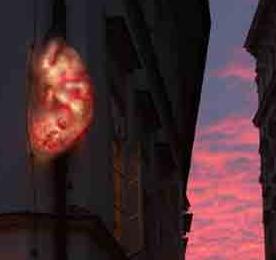  Již jednou se nás pokusil šokovat David Černý. Pokud se to nepovedlo s Viselcem, určitě se to povede u Embrya. Na rohu domu si můžeme všimnout zvláštní boule na okapu. Boule je ve tvaru lidského embrya tlačícího se z okapu do kanálu, tak kdo ví, co tím chtěl autor říci. No a pokud jste v tom embryo nepoznali, přijďte se na něj podívat po setmění, červeně pulzuje jako skutečné embryo. Svůj názor si udělejte sami. Dále doporučuji pokračovat domem čp. 188/3 s otevřeným průchodem. Již jednou se nás pokusil šokovat David Černý. Pokud se to nepovedlo s Viselcem, určitě se to povede u Embrya. Na rohu domu si můžeme všimnout zvláštní boule na okapu. Boule je ve tvaru lidského embrya tlačícího se z okapu do kanálu, tak kdo ví, co tím chtěl autor říci. No a pokud jste v tom embryo nepoznali, přijďte se na něj podívat po setmění, červeně pulzuje jako skutečné embryo. Svůj názor si udělejte sami. Dále doporučuji pokračovat domem čp. 188/3 s otevřeným průchodem.
Otázka12: Pod embryem je odhalen starý nápis, jaká je na něm třetí číslice? Dostanete L.
 We’ve already been shocked by David Černý once today. If he hasn’t managed to do so with the Hanged man, he’s certainly going to succeed with his Embryo. On the corner of the house, you can see a strange bulge on the drainpipe. The bulge formes a shape of a human embryo pushing itself from the drainpipe. Well, definitely pushing itself to the sewer, so who knows what the author wanted to say by this piece. If you can’t see the embryo in the bulge’s shapes, come to this place after nightfall, the bulge pulsates with red light, as a real embryo. You can make up your mind about it. Next, I recommend you to continue through house No. 188/3 with an open passage. We’ve already been shocked by David Černý once today. If he hasn’t managed to do so with the Hanged man, he’s certainly going to succeed with his Embryo. On the corner of the house, you can see a strange bulge on the drainpipe. The bulge formes a shape of a human embryo pushing itself from the drainpipe. Well, definitely pushing itself to the sewer, so who knows what the author wanted to say by this piece. If you can’t see the embryo in the bulge’s shapes, come to this place after nightfall, the bulge pulsates with red light, as a real embryo. You can make up your mind about it. Next, I recommend you to continue through house No. 188/3 with an open passage.
Question12: Under the embryo, an old writing is revealed. What is the third digit? Mark that down as L.
13. STAGE
Král v choulostivé poloze (The King in a delicate position)
N 50°05.177 E 014°24.856
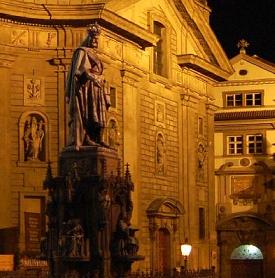  Tak když už jsme u toho šokování, šokovat budu teď i já. Pojďte se podívat na krále v poněkud choulostivé pozici. Pokud si stoupnete přesně na zadané souřadnice, přibližně doprostřed schodiště, naskytne se vám pohled na krále, který si "odskočil na malou". Je to jen taková blbinka, kterou zná málokdo, ale snad se bude líbit :-). Za vámi se ve výklenku nachází vinařský sloup, pod ním je původní dlažba z Juditina mostu a není v Praze na jediném místě. O této zajímavosti v minulosti pojednávala i tato keš ZDE. Tak když už jsme u toho šokování, šokovat budu teď i já. Pojďte se podívat na krále v poněkud choulostivé pozici. Pokud si stoupnete přesně na zadané souřadnice, přibližně doprostřed schodiště, naskytne se vám pohled na krále, který si "odskočil na malou". Je to jen taková blbinka, kterou zná málokdo, ale snad se bude líbit :-). Za vámi se ve výklenku nachází vinařský sloup, pod ním je původní dlažba z Juditina mostu a není v Praze na jediném místě. O této zajímavosti v minulosti pojednávala i tato keš ZDE.
Otázka13: Otočte se, na rohu kostela je ve výklenku vinařský sloup, po pravé straně zezadu je letopočet, jaký? 1678 (M=2), 1995 (M=4), 1925 (M=6)
 Ok, now that we’re in the shocking business, it’s my turn to shock you for a change. Let’s take a look at a king in a rather delicate position. If you place yourself precisely on the given coordinates, roughly in the middle of the stairway, you will see a king who just had to listen to his bladder’s call. It’s just a small fun fact that only few people know about, but I hope you’re gonna like it. :-) Right behind you in the niche you can see a wine column. Underneath there is the original pavement from the Judith bridge, and this is not the only place where you can find it... Ok, now that we’re in the shocking business, it’s my turn to shock you for a change. Let’s take a look at a king in a rather delicate position. If you place yourself precisely on the given coordinates, roughly in the middle of the stairway, you will see a king who just had to listen to his bladder’s call. It’s just a small fun fact that only few people know about, but I hope you’re gonna like it. :-) Right behind you in the niche you can see a wine column. Underneath there is the original pavement from the Judith bridge, and this is not the only place where you can find it...
Question13: Turn around and look at the corner of the church. There is a wine column placed in the niche and on the right back side you can see a year: 1678 (M=2), 1995 (M=4), 1925 (M=6).
14. STAGE
Juditin most (Judita’s Bridge)
N 50°05.235 E 014°24.463
  Je to trochu neuvěřitelné, ale zbytky předchůdce Karlova mostu stále lákají k procházce. Most je z období 12. století a nacházel se severněji od Karlova mostu, proto můžeme jeho zbytky nalézt ve zdejších domech, které byly postaveny na jeho základech. V hotelu Rezidence Lundborg, kde se po mostu můžeme projít, se nyní nachází hotelová kavárna. Nebojte se vstoupit, personál je na návštěvníky mostu zvyklý. Pokud se ještě více osmělíte, sejděte i po schodech dolů, kde spatříte oblouk mostu. Je to trochu neuvěřitelné, ale zbytky předchůdce Karlova mostu stále lákají k procházce. Most je z období 12. století a nacházel se severněji od Karlova mostu, proto můžeme jeho zbytky nalézt ve zdejších domech, které byly postaveny na jeho základech. V hotelu Rezidence Lundborg, kde se po mostu můžeme projít, se nyní nachází hotelová kavárna. Nebojte se vstoupit, personál je na návštěvníky mostu zvyklý. Pokud se ještě více osmělíte, sejděte i po schodech dolů, kde spatříte oblouk mostu.
Otázka14: Kolik má hotel Rezidence Lundborg pater s okny? (N=6),(N=4), (N=2).
 It’s almost unbelievable, but the Charles bridge predecessor’s remnants still lure you to visit them. The bridge dates back to the 12th century and it was standing north from the Charles bridge, which is why we can find its remnants in the local houses built on its foundations. The Hotel Rezidence Lundborg in which you can walk over the remains of the bridge is a hotel cafe today. Don’t be afraid to enter, the staff is used to the bridge’s visitors. If you dare for more, you can go down the stairs to see the bridge’s arch. It’s almost unbelievable, but the Charles bridge predecessor’s remnants still lure you to visit them. The bridge dates back to the 12th century and it was standing north from the Charles bridge, which is why we can find its remnants in the local houses built on its foundations. The Hotel Rezidence Lundborg in which you can walk over the remains of the bridge is a hotel cafe today. Don’t be afraid to enter, the staff is used to the bridge’s visitors. If you dare for more, you can go down the stairs to see the bridge’s arch.
Question14: How many floors with windows does the hotel Rezidence Lundborg have? (N=6),(N=4), (N=2).
15. STAGE
Rýhy ve zdi (The Furrows in the Wall)
N 50°05.233 E 014°24.413
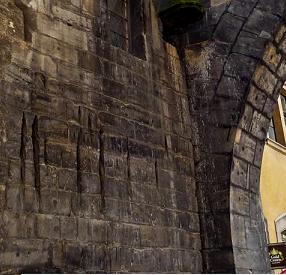  Denně tudy projde tisíce lidí, ale jen málokterý si tohoto všimne. Když už všimne, začne přemýšlet. Udělal to snad nějaký vandal? A proč už rýhy nebyly dávno opraveny? Kdo je tam vlastně vytvořil? Po bližším prozkoumání zjistíme, že rýhy už tu nějaký čas budou. A skutečně, pochází totiž ještě z dob, kdy toto místo hlídali stráže s halapartnami, kteří si o zeď své zbraně brousili. Tak, záhada rozluštěna, ale sympatická, že? Po Praze je těchto rýh mnoho, tak hlavu vzhůru a víc koukat. Denně tudy projde tisíce lidí, ale jen málokterý si tohoto všimne. Když už všimne, začne přemýšlet. Udělal to snad nějaký vandal? A proč už rýhy nebyly dávno opraveny? Kdo je tam vlastně vytvořil? Po bližším prozkoumání zjistíme, že rýhy už tu nějaký čas budou. A skutečně, pochází totiž ještě z dob, kdy toto místo hlídali stráže s halapartnami, kteří si o zeď své zbraně brousili. Tak, záhada rozluštěna, ale sympatická, že? Po Praze je těchto rýh mnoho, tak hlavu vzhůru a víc koukat.
Otázka15: Po levé straně je knihkupectví, v rohu zde končí končí zdobení Malostranské mostecké brány postavou? beránka (O=1), lva (O=2), draka (O=3).
 Thousands of people walk through this place every day, but only a few take notice of this strangeness – and if they do, they start ti think. Is this a work of some vandal? And why haven’t these furrows been repaired long since now? Who made these anyway? If you examine the furrows more closely, you’ll find out that they must’ve been here for quite some time. And really, they date back to the times when this place was patrolled by guards with halberds who were sharpening their weapons on the wall. So, mystery solved, a quite nice one, isn’t it? You can find many furrows in Prague, so heads up adn look more around! Thousands of people walk through this place every day, but only a few take notice of this strangeness – and if they do, they start ti think. Is this a work of some vandal? And why haven’t these furrows been repaired long since now? Who made these anyway? If you examine the furrows more closely, you’ll find out that they must’ve been here for quite some time. And really, they date back to the times when this place was patrolled by guards with halberds who were sharpening their weapons on the wall. So, mystery solved, a quite nice one, isn’t it? You can find many furrows in Prague, so heads up adn look more around!
Question15: On the left side there is a bookstore and in the corner the special decorating of the Malostranska gate ends with a figure of: a lamb(O=1), lion(O=2), dragon(O=3).
16. STAGE
Středověká věž (The Medieval Tower)
N 50°05.244 E 014°24.362
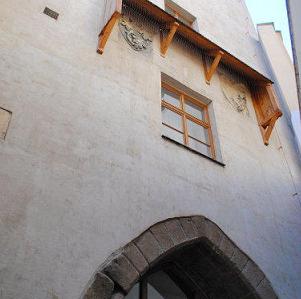  V Praze je před zraky turistů ukryto několik obranných věží z dob dávno minulých. Jedna se nachází v ulici Bartolomějská ve vnitrobloku Policie ČR. Další se nachází zde v domě čp. 16. Byla součástí Biskupského dvora, kde do roku 1420 sídlil biskup, pak byl dvůr srovnán se zemí Husity a nový byl postaven vedle Pražského hradu. Věž nechal postavit druhý pražský arcibiskup Jan Očko z Vlašimi, jehož znaky najdeme na věži dodnes. Dříve bylo možné si věž bez problému prohlédnout, v současnosti zde ale sídlí restaurace s nepříjemnou obsluhou, která nemá ráda Čechy, tak se jí prosím obloukem vyhněte, necháme ji zkrachovat a třeba si věž zase v budoucnu prohlédneme, dík! :) V Praze je před zraky turistů ukryto několik obranných věží z dob dávno minulých. Jedna se nachází v ulici Bartolomějská ve vnitrobloku Policie ČR. Další se nachází zde v domě čp. 16. Byla součástí Biskupského dvora, kde do roku 1420 sídlil biskup, pak byl dvůr srovnán se zemí Husity a nový byl postaven vedle Pražského hradu. Věž nechal postavit druhý pražský arcibiskup Jan Očko z Vlašimi, jehož znaky najdeme na věži dodnes. Dříve bylo možné si věž bez problému prohlédnout, v současnosti zde ale sídlí restaurace s nepříjemnou obsluhou, která nemá ráda Čechy, tak se jí prosím obloukem vyhněte, necháme ji zkrachovat a třeba si věž zase v budoucnu prohlédneme, dík! :)
Otázka16: V ulici je nahoře na vedlejším domu po pravé straně (čp.48/14) busta člověka, který zde žil. Kdo to byl? L. Zelenka(P=1), M. Hrubeš(P=2), L. Baarova(P=3).
 In Prague, several defense towers from the times long gone are hidden from tourist’s eyes. One of them can be found in the Czech police courtyard in Bartolomějská street and there is no easy way to get to it. Another one can be found right here in the house No. 16. It was a part of the Bishop’s courtyard where the Bishop resided until 1420 – at that year, the Hussites demolished the courtyard and a new one was built by the Prague Castle. The tower was constructed on behalf of the second Prague Archbishop Jan Očko from Vlašim, whose insignia can be found on the tower even today. It was possible to explore the tower without a problem before. But there’s a restaurant in here now and the waitress are little unpleasant. They don’t like Czech tourists, only the foreign ones that promise them huge tip :). So it would be better to avoid the restaurant, let them go bankrupt and maybe the tower will be accessible once again :). In Prague, several defense towers from the times long gone are hidden from tourist’s eyes. One of them can be found in the Czech police courtyard in Bartolomějská street and there is no easy way to get to it. Another one can be found right here in the house No. 16. It was a part of the Bishop’s courtyard where the Bishop resided until 1420 – at that year, the Hussites demolished the courtyard and a new one was built by the Prague Castle. The tower was constructed on behalf of the second Prague Archbishop Jan Očko from Vlašim, whose insignia can be found on the tower even today. It was possible to explore the tower without a problem before. But there’s a restaurant in here now and the waitress are little unpleasant. They don’t like Czech tourists, only the foreign ones that promise them huge tip :). So it would be better to avoid the restaurant, let them go bankrupt and maybe the tower will be accessible once again :).
Question16: In the street on the right side (nr.48/14), there’s a bust of a person who once lived here. Who was it? L. Zelenka(P=1), M. Hrubeš(P=2), L. Baarova(P=3).
17. STAGE
Šestiprsťák (The Sixfinger)
N 50°05.292 E 014°24.223
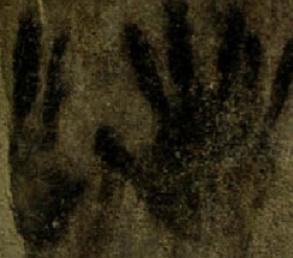  Stojíte před velkou bránou do domu, vstup je ozdoben barokním portálem a slouží jako vchod do restaurace, která nese stejný název, jako dům samotný. Vstupte do průchodu, zabočte doleva k restauraci a objevíte další malou zajímavost, o které ví málokdo, černý otisk rukou, který odkryli při rekonstrukci zedníci. Nebylo by to nic zajímavého, ale tento otisk má na pravé ruce šest prstů! A ani levá ruka na tom není o moc lépe, chybí na ní palec. Jak je otisk starý nikdo neví, ale podle omítky už tu pár set let bude. Mohl by dokonce pamatovat jezuity, kteří v tomto domě měli sídlo. Možná ho tu zanechal člen řádu nebo jen kominík či kuchař, který zrovna připálil hrnec, kdo ví. Stojíte před velkou bránou do domu, vstup je ozdoben barokním portálem a slouží jako vchod do restaurace, která nese stejný název, jako dům samotný. Vstupte do průchodu, zabočte doleva k restauraci a objevíte další malou zajímavost, o které ví málokdo, černý otisk rukou, který odkryli při rekonstrukci zedníci. Nebylo by to nic zajímavého, ale tento otisk má na pravé ruce šest prstů! A ani levá ruka na tom není o moc lépe, chybí na ní palec. Jak je otisk starý nikdo neví, ale podle omítky už tu pár set let bude. Mohl by dokonce pamatovat jezuity, kteří v tomto domě měli sídlo. Možná ho tu zanechal člen řádu nebo jen kominík či kuchař, který zrovna připálil hrnec, kdo ví.
Otázka17: Po levé straně od vstupu do paláce je na vedlejším domu ve zlaté elipse číslo domu ve tvaru? Nr.3(Q=5), Numero 3(Q=6), Nro.3(Q=7)
 You’re standing in front of a large house gate, it is decorated by a Baroque portal and serves as an entrance to a restaurant carrying the same name as the house. Enter the passage, turn left to the restaurant and you’ll discover another interesting thing only few people know about – a black handprint which was uncovered by masons during the reconstruction of this place. It wouldn’t be of much interest, had it not been for six fingers on the right hand! The left hand is not so much better off, the thumb is missing there. No one knows how old this print is, but taking the plaster into consideration, it’s been here for several centuries. It might even date back to the Jesuits who used to have their residence here. Maybe it was left here by a member of the order, or by a chimney-sweeper or a cook who’s just burned a pot, who knows? You’re standing in front of a large house gate, it is decorated by a Baroque portal and serves as an entrance to a restaurant carrying the same name as the house. Enter the passage, turn left to the restaurant and you’ll discover another interesting thing only few people know about – a black handprint which was uncovered by masons during the reconstruction of this place. It wouldn’t be of much interest, had it not been for six fingers on the right hand! The left hand is not so much better off, the thumb is missing there. No one knows how old this print is, but taking the plaster into consideration, it’s been here for several centuries. It might even date back to the Jesuits who used to have their residence here. Maybe it was left here by a member of the order, or by a chimney-sweeper or a cook who’s just burned a pot, who knows?
Question17: On the left side from the entrance to the palace on the side house there is a house number in the golden ellipse. What is the exact form of the number? Nr.3(Q=5), Numero 3(Q=6), Nro.3(Q=7)
18. STAGE
Dostanu vás do kouta (I’ll get you cornered)
N 50°05.267 E 014°24.139

 Na tomto místě se nachází hned několik zajímavostí. Předně si všimněte zajímavých patníků na chodníku před palácem. Znázorňují dvacet sedm českých pánů, popravených v roce 1621, vytvořil je sochař Karel Nepraš v roce 1993. Místo pro ně není vybráno náhodou, palác patříval knížeti Karlovi z Lichtenštejna, který rozhodl o tomto krutém potrestání vůdců stavovského povstání. Další zajímavostí na těchto souřadnicích je málo známý průchod Rubín, který můžete použít v cestě dál. Na tomto místě se nachází hned několik zajímavostí. Předně si všimněte zajímavých patníků na chodníku před palácem. Znázorňují dvacet sedm českých pánů, popravených v roce 1621, vytvořil je sochař Karel Nepraš v roce 1993. Místo pro ně není vybráno náhodou, palác patříval knížeti Karlovi z Lichtenštejna, který rozhodl o tomto krutém potrestání vůdců stavovského povstání. Další zajímavostí na těchto souřadnicích je málo známý průchod Rubín, který můžete použít v cestě dál.
Otázka18: Vstupte do průchodu a uprostřed se podívejte nad sebe, kolik pater (řad) oken vidíte na užších stranách? tři(R=9), čtyři(R=8), dvě(R=7)
 In this place, no less than several interesting phenomenona can be spotted. First, take notion of the interesting bollards on the pavement in front of the palace. Created by the sculptor Karel Nepraš in 1993, they are a reminder of the twenty seven Bohemian leaders executed in 1621. The place was not chosen by accident, this palace belonged to Prince Charles from Liechtenstein who sealed the fates of Bohemian revolt‘s leaders with this cruel punishment. Another interesting place on these coordinates is the scarcely known „Rubín“ (Ruby) passage which you can use for your further journey. In this place, no less than several interesting phenomenona can be spotted. First, take notion of the interesting bollards on the pavement in front of the palace. Created by the sculptor Karel Nepraš in 1993, they are a reminder of the twenty seven Bohemian leaders executed in 1621. The place was not chosen by accident, this palace belonged to Prince Charles from Liechtenstein who sealed the fates of Bohemian revolt‘s leaders with this cruel punishment. Another interesting place on these coordinates is the scarcely known „Rubín“ (Ruby) passage which you can use for your further journey.
Question18: When you enter the passage, stop in the middle and look up you’ll see how many floors (rows) of window on the narrower sides? Three(R=9), four(R=8), two(R=7).
19. STAGE
Pražská Itálie (The Prague Italy)
N 50°05.248 E 014°24.061
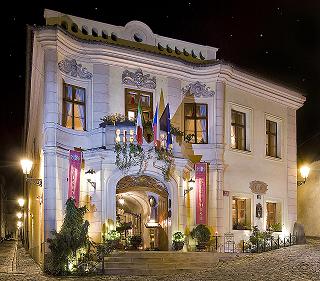
 Nyní se podíváme do klidné a krásné části Prahy přezdívané "Pražská Itálie". Najdeme zde několik úzkých uliček, honosné paláce a když se tu tak budeme procházet, budeme si připadat jako v Itálii. A není to náhodou, dnešní podoba ulic je z období kolem roku 1600, kdy se tu usadila početná italská komunita (Vlaši) v čele s architektem Oldřichem Avostalisem, který se při výstavbě domů nechal inspirovat rodnou Itálií a vznikl zde i Vlašský špitál. I dnes tu vlaje několik italských vlajek a sídlí zde kulturní centrum italského velvyslanectví. Nyní se podíváme do klidné a krásné části Prahy přezdívané "Pražská Itálie". Najdeme zde několik úzkých uliček, honosné paláce a když se tu tak budeme procházet, budeme si připadat jako v Itálii. A není to náhodou, dnešní podoba ulic je z období kolem roku 1600, kdy se tu usadila početná italská komunita (Vlaši) v čele s architektem Oldřichem Avostalisem, který se při výstavbě domů nechal inspirovat rodnou Itálií a vznikl zde i Vlašský špitál. I dnes tu vlaje několik italských vlajek a sídlí zde kulturní centrum italského velvyslanectví.
Otázka19: Po příchodu je po vaší levé ruce americké velvyslanectví. Na jeho zdi je odkrytý starý nápis dokládající přítomnost špitálu. Vespod je číslo 4*-52. Hvězdičku doplňte, získáte S.
 Now, let’s take a look at a quiet and beautiful part of Prague nicknamed „The Prague Italy“. We can find several narrow alleys here, just as some pretentious palaces – when you take a walk here, you’ll feel just like in Italy. And it’s no accident – the streets date back to 1600 when a large number of Italians settled here, led by an architect named Oldřich Avostalis who let himself be inspired by his Italian background in the construction of the houses and even built the Italian hospital here. Today, several Italian flags flutter in the wind here as the cultural centre of the Italian Embassy which resides in this house. Now, let’s take a look at a quiet and beautiful part of Prague nicknamed „The Prague Italy“. We can find several narrow alleys here, just as some pretentious palaces – when you take a walk here, you’ll feel just like in Italy. And it’s no accident – the streets date back to 1600 when a large number of Italians settled here, led by an architect named Oldřich Avostalis who let himself be inspired by his Italian background in the construction of the houses and even built the Italian hospital here. Today, several Italian flags flutter in the wind here as the cultural centre of the Italian Embassy which resides in this house.
Question19: There’s an American embassy to your left. On it’s wall, and old sign documents the presence of a hospital. In the lower part, you will see numbers 4*-52. You need to replace the star with the correct digit and you'll get S.
20. STAGE
Nejstarší sluneční hodiny (The Oldest Sundial)
N 50°05.309 E 014°23.814
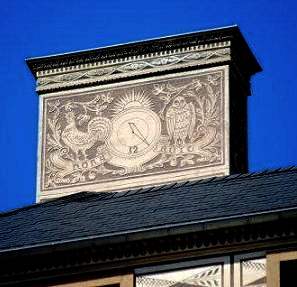  Pokud se postavíte kousek od úpatí schodů a zvednete hlavu, uvidíte krásně zdobený palác, po levé straně dále uvidíte velký komín a na komínu vyobrazené nestarší sluneční hodiny v Praze. Hodiny pocházejí z roku 1567, jsou provedeny sgrafitovou technikou a pod zobrazením kohouta a sovy je latinský nápis HORA RUIT (ČAS KVAPÍ). Náš čas ale nekvapí, tak si je v klidu prohlédněte a pomalu vzhůru do schodů. Pokud se postavíte kousek od úpatí schodů a zvednete hlavu, uvidíte krásně zdobený palác, po levé straně dále uvidíte velký komín a na komínu vyobrazené nestarší sluneční hodiny v Praze. Hodiny pocházejí z roku 1567, jsou provedeny sgrafitovou technikou a pod zobrazením kohouta a sovy je latinský nápis HORA RUIT (ČAS KVAPÍ). Náš čas ale nekvapí, tak si je v klidu prohlédněte a pomalu vzhůru do schodů.
Otázka20: Po levé straně od schodů je dům U Zlaté hvězdy, co zdobí vršek jeho dřevěných a krásně zdobených hlavních vrat? lev(T=1), obličej(T=2), hornické kladivo(T=3)
 If you step away from the base of the stairs and rise your head, you will see a beautifully decorated palace, a large chimney to your left and, on the chimney, the oldest sundial in Prague. It was created using the sgraffito technique in 1567 and under the picture of a rooster and an owl, the writing „HORA RUIT“ („Time is running“) can be found. Our time is not running that fast, though, so take a good look at the sundial and then start to climb the stairs. If you step away from the base of the stairs and rise your head, you will see a beautifully decorated palace, a large chimney to your left and, on the chimney, the oldest sundial in Prague. It was created using the sgraffito technique in 1567 and under the picture of a rooster and an owl, the writing „HORA RUIT“ („Time is running“) can be found. Our time is not running that fast, though, so take a good look at the sundial and then start to climb the stairs.
Question20: On the left side from the stairs is the house of the Golden Star, what decorate the top of his wood main gate? Lion(T=1), face(T=2), mining hammer(T=3)
21. STAGE
Zázračná mumie (The Miraculous Mummy)
N 50°05.351 E 014°23.737
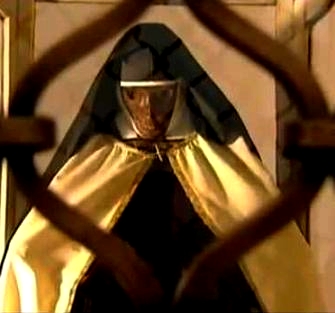  Fascinující, ale pozapomenutý pražský příběh doposud žije za zdmi kláštera, u kterého nyní stojíme. Uvnitř chrámu, za sklem a mříží ve výklenku vpravo od oltáře, lze spatřit zachované tělo první převorky zdejšího řádu, matky Elekty. Má lehce pootevřené oči i ústa, která jako by se stále usmívala, v rukou svírá krucifix a růženec. Zemřela v roce 1663 a byla pohřbena v dost neuctivých podmínkách v kapli ve Vojanových sadech, roku 1666 ale byla po sérii zvláštních úkazů vyzdvižena a tělo, i když leželo v mokré kaluži a plísni, bylo naprosto neporušené! Následně byla posazena do křesla a věřilo se, že vyléčí nemoci. V roce 1950 byl klášter komunisty vyklizen, matka Elekta tu ale zůstala a budova sloužila jako hotel pro výše postavené soudruhy a šuškalo se, že je to spíše nevěstinec. V roce 1992 byl klášter navrácen, v kostele se pořádají nedělní mše a je možné Elektu po deváté večerní spatřít. V současné době se dokonce zvažuje její blahoslavení, čímž by se stala svatou, díky jejím zázrakům. Fascinující, ale pozapomenutý pražský příběh doposud žije za zdmi kláštera, u kterého nyní stojíme. Uvnitř chrámu, za sklem a mříží ve výklenku vpravo od oltáře, lze spatřit zachované tělo první převorky zdejšího řádu, matky Elekty. Má lehce pootevřené oči i ústa, která jako by se stále usmívala, v rukou svírá krucifix a růženec. Zemřela v roce 1663 a byla pohřbena v dost neuctivých podmínkách v kapli ve Vojanových sadech, roku 1666 ale byla po sérii zvláštních úkazů vyzdvižena a tělo, i když leželo v mokré kaluži a plísni, bylo naprosto neporušené! Následně byla posazena do křesla a věřilo se, že vyléčí nemoci. V roce 1950 byl klášter komunisty vyklizen, matka Elekta tu ale zůstala a budova sloužila jako hotel pro výše postavené soudruhy a šuškalo se, že je to spíše nevěstinec. V roce 1992 byl klášter navrácen, v kostele se pořádají nedělní mše a je možné Elektu po deváté večerní spatřít. V současné době se dokonce zvažuje její blahoslavení, čímž by se stala svatou, díky jejím zázrakům.
Otázka21: Všimněte si krásně zdobených tmavých hlavních dveří do kláštera. Jaký je v jejich spodku letopočet? 1655(U=6), 1666(U=7), 1855(U=8)
 Fascinating, but almost forgotten Prague story still lives behind the walls of the monastery at which we’re now standing. Inside the temple, behind a glass and bars in a niche to the right of the altar, you can see a preserved body of the first prioress of the local order, mother Elekta. Her eyes and mouth are slightly open, as if eternally smiling, and in her hands are the crucifix and rosary. She died in 1663 and was buried under rather disrespectful conditions in a chapel in Vojanovy sady in 1666. After several strange apparitions, though, she was raised from the grave and the body, while lying in a damp puddle and mold, was absolutely intact! She was then seated in a chair and it was believed that she has the ability to heal diseases. In 1950, the Communists cleared out the monastery, but Elekta stayed here and the building served as a hotel for the higher-ranking comrades – but rumor had it that it was rather a brothel. In 1992, the monastery was returned to the order, Sunday services are being held in the church since and Elekta can be seen after nine in the evening. Nowadays, a possibility of Elekta’s blessing is being considered. It would make her a saint for her miracles. Fascinating, but almost forgotten Prague story still lives behind the walls of the monastery at which we’re now standing. Inside the temple, behind a glass and bars in a niche to the right of the altar, you can see a preserved body of the first prioress of the local order, mother Elekta. Her eyes and mouth are slightly open, as if eternally smiling, and in her hands are the crucifix and rosary. She died in 1663 and was buried under rather disrespectful conditions in a chapel in Vojanovy sady in 1666. After several strange apparitions, though, she was raised from the grave and the body, while lying in a damp puddle and mold, was absolutely intact! She was then seated in a chair and it was believed that she has the ability to heal diseases. In 1950, the Communists cleared out the monastery, but Elekta stayed here and the building served as a hotel for the higher-ranking comrades – but rumor had it that it was rather a brothel. In 1992, the monastery was returned to the order, Sunday services are being held in the church since and Elekta can be seen after nine in the evening. Nowadays, a possibility of Elekta’s blessing is being considered. It would make her a saint for her miracles.
Question21: Note the beautiful decorations on the main doorway to the monastery. What year is written on the bottom part of the door? 1655(U=6), 1666(U=7), 1855(U=8)
22. STAGE
Toskánská ulička (The Tuscan street)
N 50°05.380 E 014°23.715
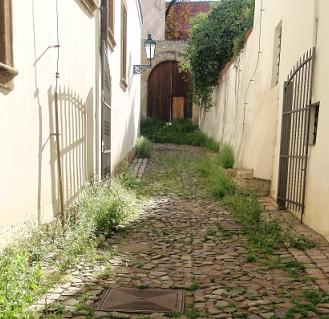  Když už vás provázím zapadlými uličkami, nemohu vynechat tuto. Připravte se na těžkou romantiku. Málokdo ji zná, málokdo do ní zajde, vypadá totiž nenápadně jako vchod do dvora nějakého paláce. Dokonce ji nenajdete ani na mapě a také to podle toho v ní vypadá, květena si tu dělá naprosto, co chce a není nikdo, kdo by jí pošlapal. Ulička byla v roce 2010 zpřístupněná, ale nyní je znovu uzavřená. Pozor, ve večerních hodinách je brána do uličky uzavřená, pouze pod bránou prosvítá světlo a pokud jste zvědaví, můžete se sehnout a nahlédnout.Ulička končí na souřadnicích N 50°05.338 E 014°23.682. Zde se můžete podívat klíčovou dírkou masivních dveří a uvidíte uličku duchů také :-). Když už vás provázím zapadlými uličkami, nemohu vynechat tuto. Připravte se na těžkou romantiku. Málokdo ji zná, málokdo do ní zajde, vypadá totiž nenápadně jako vchod do dvora nějakého paláce. Dokonce ji nenajdete ani na mapě a také to podle toho v ní vypadá, květena si tu dělá naprosto, co chce a není nikdo, kdo by jí pošlapal. Ulička byla v roce 2010 zpřístupněná, ale nyní je znovu uzavřená. Pozor, ve večerních hodinách je brána do uličky uzavřená, pouze pod bránou prosvítá světlo a pokud jste zvědaví, můžete se sehnout a nahlédnout.Ulička končí na souřadnicích N 50°05.338 E 014°23.682. Zde se můžete podívat klíčovou dírkou masivních dveří a uvidíte uličku duchů také :-).
Otázka22: Po pravé straně před vstupem do uličky je dům, na kterém je po pravé straně dveří zvonek. Kdo tu bydlí? Smetana(V=2), Mucha(V=4), Kadeřábek(V=6)
 As I’m guiding you through some godforsaken alleys, I can’t leave out this one. Get ready for some serious romance! Really few people know this street, really few people go there, since it looks very inconspicuous, more like an entrance to some palace’s courtyard. You can’t even find it on a map – and the place looks according to this fact. The vegetation rules supreme and there’s no one to trample it down. The street was opened to public in 2010, but is now closed again. Please notice that the small street is closed during the evening hours, only down the street lights shine through the closed doors. But if you’re curious you can take a peek through this hole. The street ends at coordinates N 50 ° 05,338 E 014 ° 23.682. There look through a keyhole of solid wood doors and see ghost street too :-). As I’m guiding you through some godforsaken alleys, I can’t leave out this one. Get ready for some serious romance! Really few people know this street, really few people go there, since it looks very inconspicuous, more like an entrance to some palace’s courtyard. You can’t even find it on a map – and the place looks according to this fact. The vegetation rules supreme and there’s no one to trample it down. The street was opened to public in 2010, but is now closed again. Please notice that the small street is closed during the evening hours, only down the street lights shine through the closed doors. But if you’re curious you can take a peek through this hole. The street ends at coordinates N 50 ° 05,338 E 014 ° 23.682. There look through a keyhole of solid wood doors and see ghost street too :-).
Question22: To the right from the alley entrance, there’s a house with a doorbell on the right side of the door. Who lives here? Smetana(V=2), Mucha(V=4), Kadeřábek(V=6)
23. STAGE
Zvláštní terasa (Stranger terrace)
N 50°05.302 E 014°23.480
  Této zvláštní terasy si mnozí vůbec nevšimnou a přitom má velmi zajímavý půdorys. Její složitý půdorys má jednoduché vysvětlení. Je zde tímto způsobem vyznačen půdorys barokní kaple svatého Matouše, postavené v letech 1726-1732. Kaple nepřežila reformy císaře Josefa II. a byla stržena v roce 1799. Ve zdivu je naznačena část hmoty zdiva kaple, do které je vloženo několik fragmentů kamenných náhrobků z archeologických průzkumů zdejšího středověkého pohřebiště. Této zvláštní terasy si mnozí vůbec nevšimnou a přitom má velmi zajímavý půdorys. Její složitý půdorys má jednoduché vysvětlení. Je zde tímto způsobem vyznačen půdorys barokní kaple svatého Matouše, postavené v letech 1726-1732. Kaple nepřežila reformy císaře Josefa II. a byla stržena v roce 1799. Ve zdivu je naznačena část hmoty zdiva kaple, do které je vloženo několik fragmentů kamenných náhrobků z archeologických průzkumů zdejšího středověkého pohřebiště.
Otázka23: Zde najdeme sochu na podstavci a na něm letopočty. Jaké zlaté číslo je nejvíce zastoupeno? (W=4), (W=6), (W=8)
 Many people don’t even notice this strange terrace, yet it has a very interesting floor projection. This projection has a simple explanation. In this manner, the floor projection of the baroque chapel of Saint Matthew, built in 1726-1732, is marked. The chapel did not survive the reforms of Joseph II and was demolished in 1799. In the masonry, some of the original chapel masonry is marked, with some fragments of tombstones from archaelogical surveys of the local medieval burial site. Many people don’t even notice this strange terrace, yet it has a very interesting floor projection. This projection has a simple explanation. In this manner, the floor projection of the baroque chapel of Saint Matthew, built in 1726-1732, is marked. The chapel did not survive the reforms of Joseph II and was demolished in 1799. In the masonry, some of the original chapel masonry is marked, with some fragments of tombstones from archaelogical surveys of the local medieval burial site.
Question23: Here you can find a statue on a pedestal with numbers. Which golden digit appears the most? (W=4), (W=6), (W=8)
FINAL STAGE!
Je ukryta na souřadnicích:
It is hidden on the coordinates:
N (A-C)(H-L).(C-P)(N+C).(B+E-M)(O*K/T)(F+V)
E 0(N-D)(G-D).(S-A)(I-U).(R-V)(Q-K-C)(W-J+E)
Gratuluji! Pokud znáte nějakou zajímavou pražskou maličkost, podělte se o ni prosím do logu. Děkuji! Pokud se bude nacházet na trase této multiny, rád ji přidám do referenčních waypointů.
Congratulations! If you know some other Prague small-monuments, please share it into log. Thank you!

|